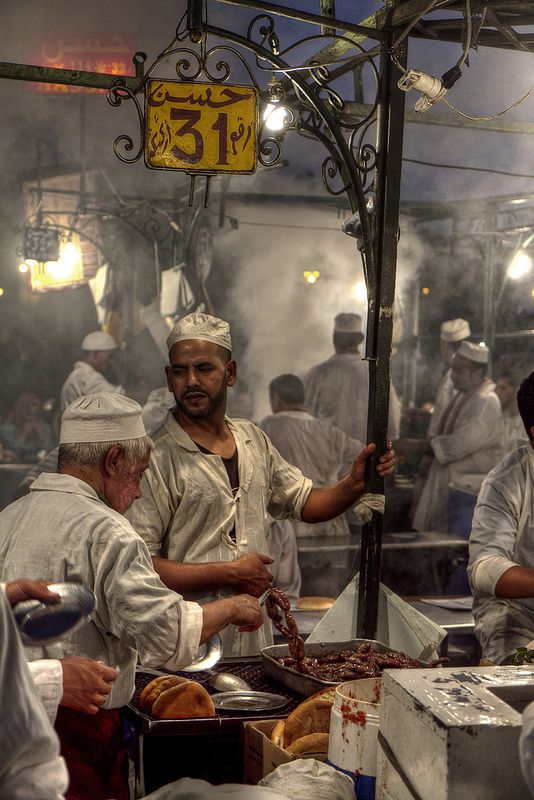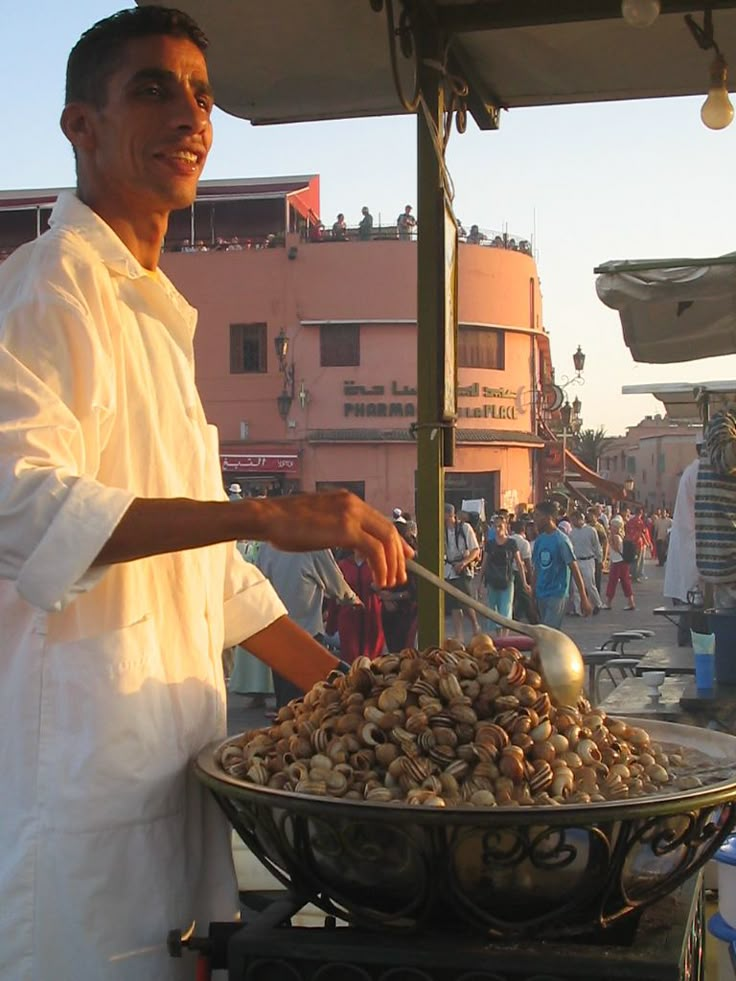When you think of Morocco, images of vibrant souks, historic medinas, and sweeping desert landscapes might come to mind. But there’s another side to this North African kingdom that deserves just as much attention: Moroccan street food. It’s more than just food – it’s a living story told in spices, sizzling grills, and steaming tagines, bringing together tradition, innovation, and pure flavor.
In this article, we’ll take you on a flavorful journey through the bustling streets of Morocco, from the heart of Marrakech to the coastal charm of Essaouira, uncovering the iconic dishes that define Moroccan street food.

A Taste of Tradition: What Makes Moroccan Street Food Unique?
Street eats in Morocco are deeply rooted in centuries-old culinary traditions. Known for bold spices, rich textures, and cultural depth, these savory bites offer more than just flavor — they tell a story.
Whether you’re exploring a narrow alleyway in Fez or wandering the seaside promenade in Agadir, the street food experience is an essential part of Moroccan culture.
What makes Street delicacies truly special is how it blends convenience with authenticity. Every bite reflects a rich cultural heritage, often prepared by vendors using family recipes passed down through generations.
Iconic Moroccan Street Food You Must Try
Here’s a closer look at some of the most beloved Local food scene dishes that you absolutely shouldn’t miss.
1. Msemen – The Moroccan Street Pancake
This square-shaped, flaky flatbread is a staple of Moroccan breakfasts and street snacks. Often served hot off the griddle, msemen can be enjoyed plain or filled with onions, spices, or honey. Street vendors in cities like Casablanca or Tangier usually serve it with a cup of mint tea, making it a perfect morning treat.
2. Harira – Comfort in a Bowl
Typically served during Ramadan but available all year round, harira is a hearty soup made from lentils, chickpeas, tomatoes, and fresh herbs. Vendors serve it steaming hot with a squeeze of lemon and a side of chebakia (a sesame cookie), offering a blend of sweet and savory flavors that define Moroccan street food comfort.
3. Babouch – Moroccan Snail Soup
A must-try on cool evenings in cities like Casablanca or Rabat, Babouch is a traditional Moroccan street food delicacy made from snails simmered in a rich, spiced broth. The flavorful soup is infused with a mix of herbs and spices such as anise, thyme, licorice root, and wild mint – believed to have medicinal and digestive benefits.
Often served piping hot in small cups or bowls from street carts, locals enjoy both the snails and the broth, known as “merqa”, sipping it for its warming and soothing properties. This dish offers a unique, authentic experience that reflects Morocco’s deep culinary heritage and is perfect for adventurous food lovers.
4. Sfenj – Moroccan Donuts
No Moroccan street food adventure is complete without sfenj. These deep-fried, airy donuts are often enjoyed as a mid-morning or afternoon snack. Sprinkled with sugar or soaked in honey, they’re best eaten fresh while still hot. Vendors typically fry them in open-air stalls, and you can spot them easily by the lines of locals waiting for a batch.
Meat Lovers Rejoice: Grilled Moroccan Street Food
For those craving something heartier, Moroccan street grills offer a feast for the senses.
5. Brochettes – Skewered Perfection
Marinated in a mix of cumin, paprika, garlic, and herbs, Moroccan brochettes are skewers of lamb, beef, or chicken grilled to perfection. Often served in pita-style bread with onions, harissa, and fries, these are a popular lunchtime favorite found in markets like Jemaa el-Fnaa in Marrakech.
6. Kefta – Spiced Ground Meat
Kefta, or spiced minced meat, is another Moroccan street food favorite. Vendors shape the meat into patties or skewers and grill it over charcoal, serving it with chopped onions, tomatoes, and fresh herbs wrapped in traditional Moroccan khobz (bread).
From the Ocean to the Streets: Seafood in Moroccan Street Food
Morocco’s long coastline offers no shortage of seafood, and this is reflected in its coastal street food.
7. Calamari and Sardines – Fresh from the Sea
In coastal cities like Essaouira and Agadir, vendors fry up calamari, sardines, and anchovies seasoned with chermoula (a spice mix made of garlic, coriander, cumin, and lemon). Served with wedges of lemon and fresh bread, this seafood feast is a must for visitors.
8. Stuffed Fish Sandwiches
Another street favorite is the fish sandwich – usually a fresh baguette stuffed with grilled or fried fish, lettuce, tomatoes, olives, and a dollop of harissa or mayonnaise. It’s fast, flavorful, and a hit among both locals and tourists.
Sweet Endings: Moroccan Street Food Desserts
Moroccan desserts are not overly sugary, but they pack tons of flavor and tradition.
9. Chebakia – Sesame and Honey Cookie
This flower-shaped pastry is made with sesame seeds, flavored with orange blossom water and cinnamon, then fried and dipped in honey. You’ll often see them during Ramadan, but some vendors offer them year-round.
10. Maakouda – The Surprise Dessert
While technically a savory potato fritter, some regions in Morocco serve a sweet version of maakouda filled with dates or nuts and lightly dusted with sugar. It’s a unique take on street food fusion you might encounter in northern towns like Tetouan.
Navigating Moroccan Street Food Like a Local
To fully enjoy Moroccan street food, here are a few tips:
- Eat where the locals eat: A long line usually means delicious food.
- Watch the preparation: Many vendors cook on the spot – it’s part of the experience.
- Ask for recommendations: Don’t hesitate to talk to locals; Moroccans are proud of their cuisine.
- Bring cash: Most street vendors don’t accept cards.
- Be open to trying new things: Some of the best dishes are the ones you’ve never heard of.
The Future of Moroccan Street Food
With Morocco embracing modern tourism, Moroccan street food continues to evolve. While traditional recipes remain sacred, new twists are emerging, blending global culinary trends with ancient Moroccan flavors. Food trucks, street food festivals, and Instagram-worthy plates are giving this tradition a fresh appeal.
Why Moroccan Street Food is a Must-Try Experience
If you’re planning a visit to Morocco, skipping out on Moroccan street food would mean missing a big part of the country’s cultural identity. Whether it’s a hot bowl of bissara on a chilly morning, a sizzling lamb brochette at night, or a sugary sfenj at tea time – every bite tells a story of heritage, family, and flavor.
From north to south, city to village, street vendors across the kingdom offer a culinary odyssey that you’ll remember long after your journey ends.
Want to taste Morocco from home? Stay tuned for our street food-inspired Moroccan recipes – coming soon!

